-
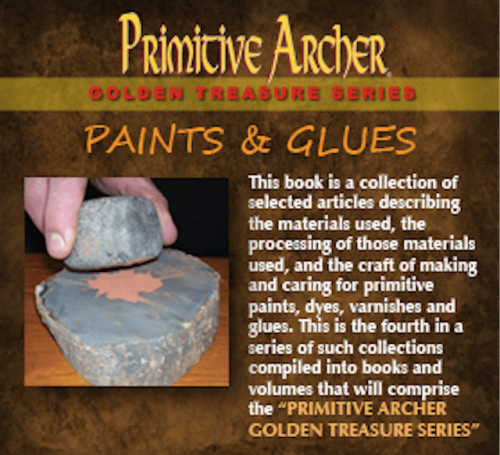 PAINTS & GLUES is packed with articles on collecting and processing earth pigments, plant and berry juices, pine pitch, sinew, rawhide and other materials used in making primitive paints, dyes, stains, varnish and glue as well as the step-by-step procedures in making each of these products. This is the fourth of a series of such collections compiled toto books and volumes that comprise the "Primitive Archer Golden Treasure Series". "Before the introduction of commercial colors, primitive cultures used natural paints and dyes that came from the earth. Those same colors are still available today and, with a little search and some work, you can find and make your own paints." Source of the quote: Author Billy Berger "In our quest to become more self-sufficient, searching out products we can make ourselves can satisfy this need. Hide glue is one of the items that can easily be made on your own ." Source of the quote: Author Mike Yancey.
PAINTS & GLUES is packed with articles on collecting and processing earth pigments, plant and berry juices, pine pitch, sinew, rawhide and other materials used in making primitive paints, dyes, stains, varnish and glue as well as the step-by-step procedures in making each of these products. This is the fourth of a series of such collections compiled toto books and volumes that comprise the "Primitive Archer Golden Treasure Series". "Before the introduction of commercial colors, primitive cultures used natural paints and dyes that came from the earth. Those same colors are still available today and, with a little search and some work, you can find and make your own paints." Source of the quote: Author Billy Berger "In our quest to become more self-sufficient, searching out products we can make ourselves can satisfy this need. Hide glue is one of the items that can easily be made on your own ." Source of the quote: Author Mike Yancey. -
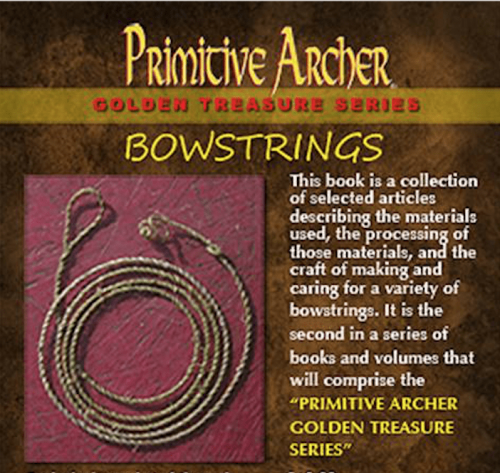
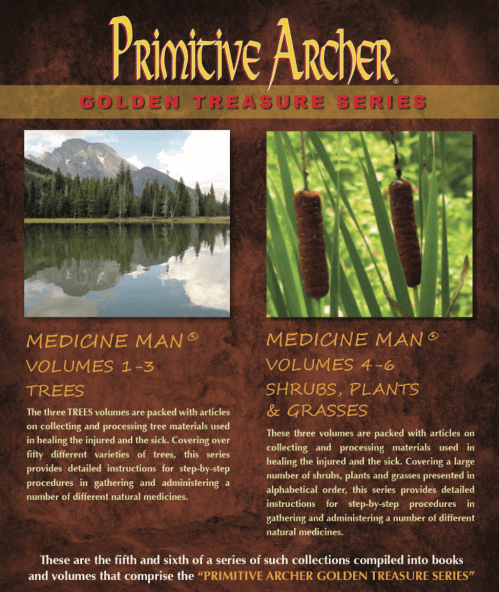 This set includes ALL 26 Golden Treasure Series books- including, All 5 Bow Making Collection; All 4 Bow Woods Volumes, All 6 Medicine Man Volumes, All 4 Arrows Volumes, All 3 Flintkapping Volumes, Quivers, Atlatls, Paints and Glues, and Bowstrings. Ships in several boxes. Ships in several boxes. You will have information on all the different types of wood used to make bows, information on plants, shrubs and trees with the Medicine Man series, and everything you would want to know about quivers, bowstrings, paints and glue, and the atlatl in your complete set of the Golden Treasure Series.
This set includes ALL 26 Golden Treasure Series books- including, All 5 Bow Making Collection; All 4 Bow Woods Volumes, All 6 Medicine Man Volumes, All 4 Arrows Volumes, All 3 Flintkapping Volumes, Quivers, Atlatls, Paints and Glues, and Bowstrings. Ships in several boxes. Ships in several boxes. You will have information on all the different types of wood used to make bows, information on plants, shrubs and trees with the Medicine Man series, and everything you would want to know about quivers, bowstrings, paints and glue, and the atlatl in your complete set of the Golden Treasure Series. -
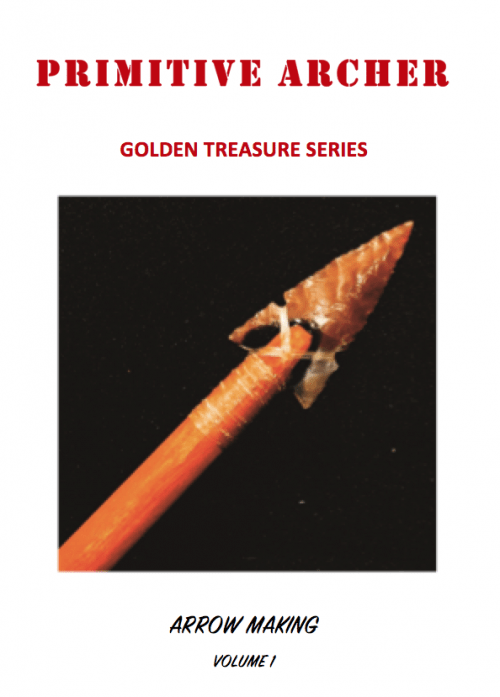 These four volumes are packed with articles describing the attributes and challenges of different styles and different techniques used in making arrows. Many of the articles take the reader step by step all the way from collection of materials to be used through to the finished arrow. Other articles focus on special challenges such as fletching, cutting nocks and spine testing arrow shafts.
These four volumes are packed with articles describing the attributes and challenges of different styles and different techniques used in making arrows. Many of the articles take the reader step by step all the way from collection of materials to be used through to the finished arrow. Other articles focus on special challenges such as fletching, cutting nocks and spine testing arrow shafts. -
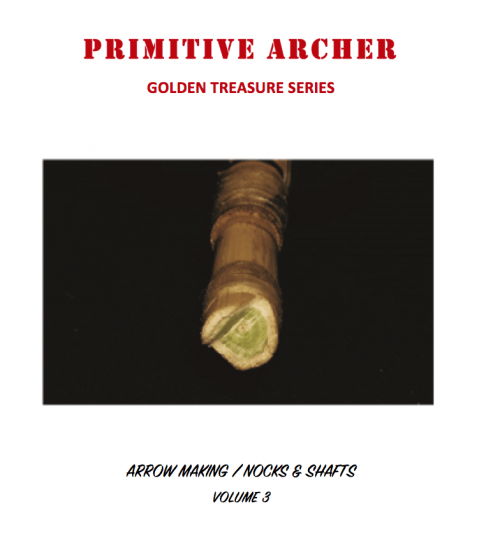 This is Volume 3 of 4 that are packed with articles describing the attributes and challenges of different styles and different techniques used in making arrows. Many of the articles take the reader step by step all the way from collection of materials to be used through to the finished arrow. Other articles focus on special challenges such as fletching, cutting nocks and spine testing arrow shafts.
This is Volume 3 of 4 that are packed with articles describing the attributes and challenges of different styles and different techniques used in making arrows. Many of the articles take the reader step by step all the way from collection of materials to be used through to the finished arrow. Other articles focus on special challenges such as fletching, cutting nocks and spine testing arrow shafts. -
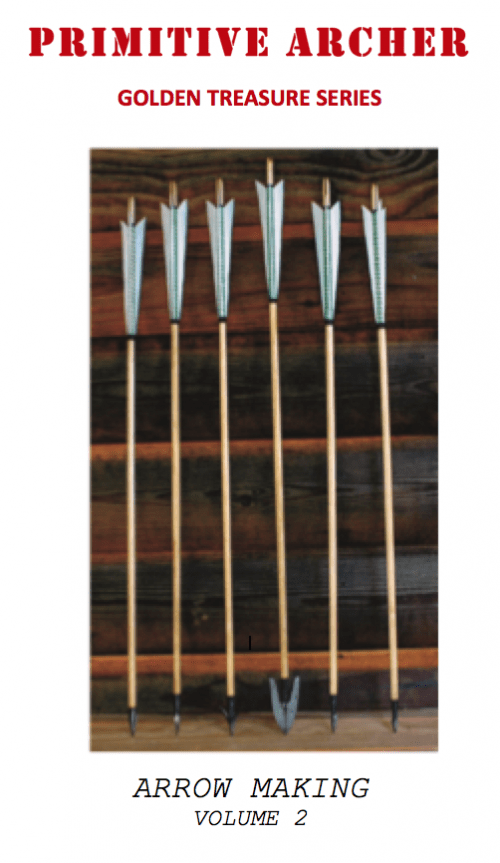 These four volumes are packed with articles describing the attributes and challenges of different styles and different techniques used in making arrows. Many of the articles take the reader step by step all the way from collection of materials to be used through to the finished arrow. Other articles focus on special challenges such as fletching, cutting nocks and spine testing arrow shafts.
These four volumes are packed with articles describing the attributes and challenges of different styles and different techniques used in making arrows. Many of the articles take the reader step by step all the way from collection of materials to be used through to the finished arrow. Other articles focus on special challenges such as fletching, cutting nocks and spine testing arrow shafts. -
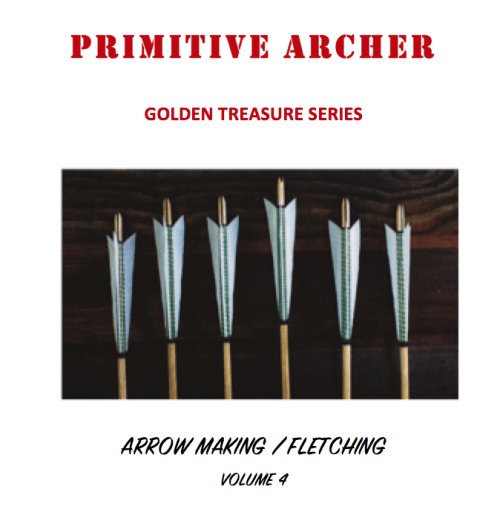 These four volumes are packed with articles describing the attributes and challenges of different styles and different techniques used in making arrows. Many of the articles take the reader step by step all the way from collection of materials to be used through to the finished arrow. Other articles focus on special challenges such as fletching, cutting nocks and spine testing arrow shafts.
These four volumes are packed with articles describing the attributes and challenges of different styles and different techniques used in making arrows. Many of the articles take the reader step by step all the way from collection of materials to be used through to the finished arrow. Other articles focus on special challenges such as fletching, cutting nocks and spine testing arrow shafts. -
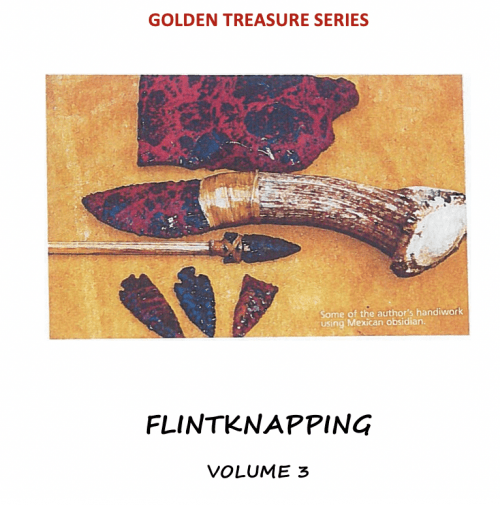 This book is a collection of selected articles describing the attributes and challenges of different styles and different techniques used in flintknapping. This is the 21st of a series of such collections compiled into books and volumes that comprise the “Primitive Archer Golden Treasure Series” Articles Include: Making The Desert Side-Notch Point by Billy Berger Glass Buttes Knap-In by Dave Cheney Let’s Make An Arrowhead – Part 3 by John McPherson Back Yard Knap-Ins by Billy Berger Replicating a Selknam Glass Arrow Point and Arrow by John Borgeson Making The Citrus Side Notched Point by Billy Berger Knapadonia by Duane Spangler From The Pit – Flintknapping FAQ by Patrick Blank From The Pit – Flintknapping FAQ by Patrick Blank Iowa Indian Artifact Show by Billy Berger From The Pit – Flintknapping FAQ by Patrick Blank
This book is a collection of selected articles describing the attributes and challenges of different styles and different techniques used in flintknapping. This is the 21st of a series of such collections compiled into books and volumes that comprise the “Primitive Archer Golden Treasure Series” Articles Include: Making The Desert Side-Notch Point by Billy Berger Glass Buttes Knap-In by Dave Cheney Let’s Make An Arrowhead – Part 3 by John McPherson Back Yard Knap-Ins by Billy Berger Replicating a Selknam Glass Arrow Point and Arrow by John Borgeson Making The Citrus Side Notched Point by Billy Berger Knapadonia by Duane Spangler From The Pit – Flintknapping FAQ by Patrick Blank From The Pit – Flintknapping FAQ by Patrick Blank Iowa Indian Artifact Show by Billy Berger From The Pit – Flintknapping FAQ by Patrick Blank -
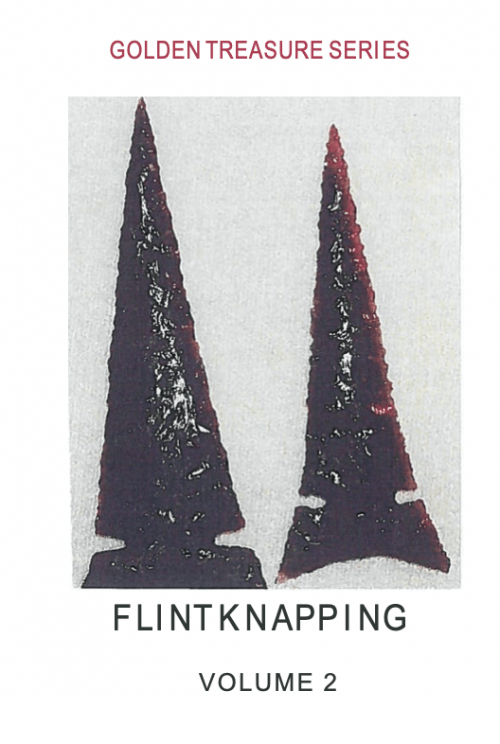 This book is a collection of selected articles describing the attributes and challenges of different styles and different techniques used in flintknapping. This is the 20th of a series of such collections compiled into books and volumes that comprise the “Primitive Archer Golden Treasure Series” Articles Include: Scary Sharp Serrations by Ryan Gill Let’s Make An Arrowhead – Part 2 by John McPherson Making The Cahokia Point by Billy Berger Rocks to Heart Shots by Ryan Gill Promoting Penetration With a Smooth Transition by Ryan Gill Making The Eastgate Arrow Point by Billy Berger Throwin’ Rocks At ‘Em by Mickey Lotz Building Self Bows and Flintknapping- Tennessee Classic by Stim Wilcox The Obsidian of Annadel and Napa Valley by Sterling Sam From The Pit – Flintknapping FAQ by Patrick Blank
This book is a collection of selected articles describing the attributes and challenges of different styles and different techniques used in flintknapping. This is the 20th of a series of such collections compiled into books and volumes that comprise the “Primitive Archer Golden Treasure Series” Articles Include: Scary Sharp Serrations by Ryan Gill Let’s Make An Arrowhead – Part 2 by John McPherson Making The Cahokia Point by Billy Berger Rocks to Heart Shots by Ryan Gill Promoting Penetration With a Smooth Transition by Ryan Gill Making The Eastgate Arrow Point by Billy Berger Throwin’ Rocks At ‘Em by Mickey Lotz Building Self Bows and Flintknapping- Tennessee Classic by Stim Wilcox The Obsidian of Annadel and Napa Valley by Sterling Sam From The Pit – Flintknapping FAQ by Patrick Blank -
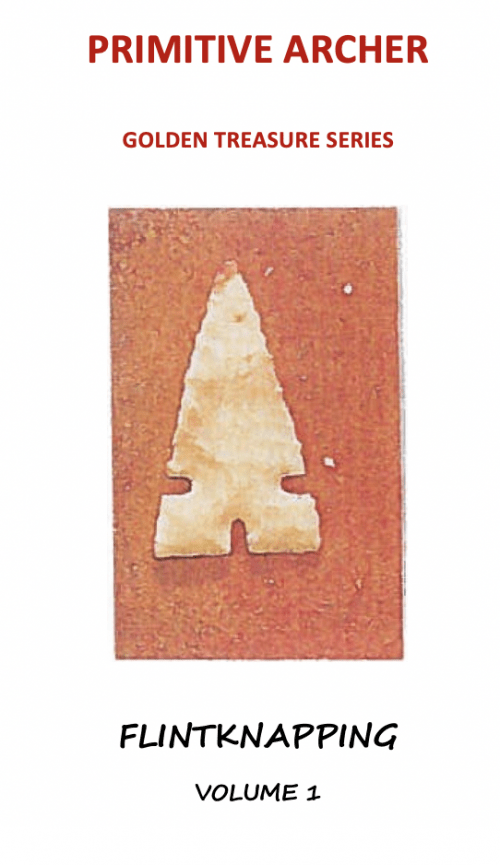 This book is a collection of selected articles describing the attributes and challenges of different styles and different techniques used in flintknapping. This is the 19th of a series of such collections compiled into books and volumes that comprise the “Primitive Archer Golden Treasure Series” Articles Include: Flintknapping Today’s Ancient Craft by John Whittaker Making That Flint Arrowhead by Roger Warmuskerken Through A Beginner’s Eyes by Steven Saffold So, Let’s Make An Arrowhead by John McPherson For The Love of Stone by Billy Berger Stone Impact Fractures by Ben Gillespie Small Town Knapper by Nikki Wetzel Solving The Primitive Arrow Weight Consistency Issues by Randall Ivie Making The Calapooya Arrow Point by Billy Berger Primitive Archery’s Lessons On Stone Tool Use...by Billy Berger Tequila – My Obsidian Obsession by Rollie Johnson From The Pit – Flintknapping FAQ by Patrick Blank From The Pit – FlinkKnapping FAQ by Patrick Blank
This book is a collection of selected articles describing the attributes and challenges of different styles and different techniques used in flintknapping. This is the 19th of a series of such collections compiled into books and volumes that comprise the “Primitive Archer Golden Treasure Series” Articles Include: Flintknapping Today’s Ancient Craft by John Whittaker Making That Flint Arrowhead by Roger Warmuskerken Through A Beginner’s Eyes by Steven Saffold So, Let’s Make An Arrowhead by John McPherson For The Love of Stone by Billy Berger Stone Impact Fractures by Ben Gillespie Small Town Knapper by Nikki Wetzel Solving The Primitive Arrow Weight Consistency Issues by Randall Ivie Making The Calapooya Arrow Point by Billy Berger Primitive Archery’s Lessons On Stone Tool Use...by Billy Berger Tequila – My Obsidian Obsession by Rollie Johnson From The Pit – Flintknapping FAQ by Patrick Blank From The Pit – FlinkKnapping FAQ by Patrick Blank -
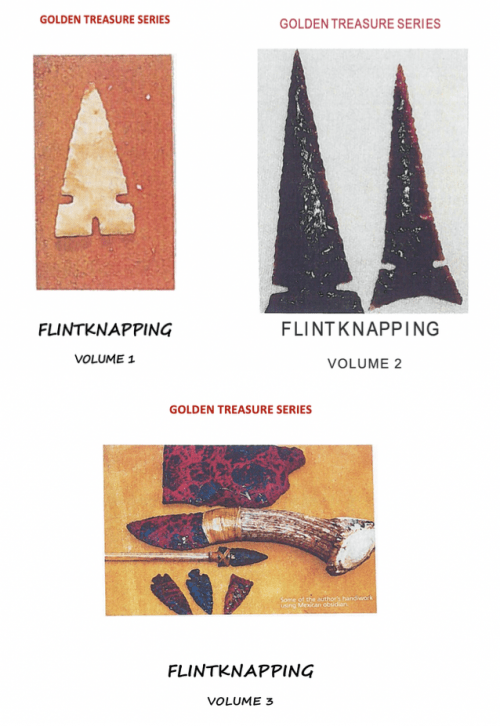
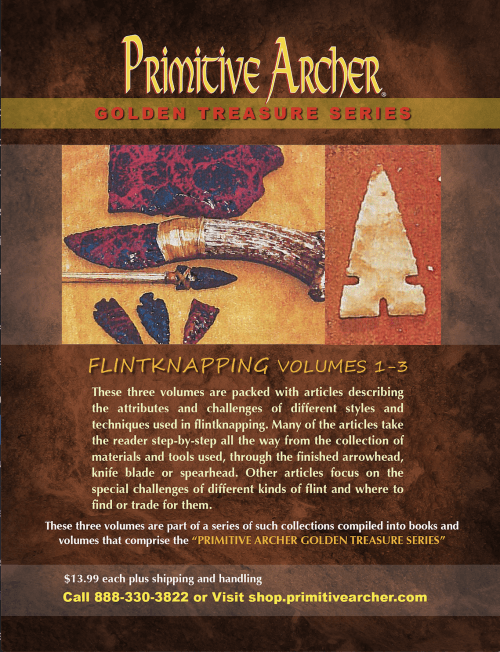 These three volumes are packed with articles describing the attributes and challenges of different styles and different techniques used in flintknapping. Many of the articles take the reader step by step all the way from the collection of materials and tools used, through the finished arrowhead, knife blade or spearhead. Other articles focus on the special challenges of different kinds of flint and where to find or trade for them. These three volumes are part of a series of such collections compiled into books and volumes that comprise the “PRIMITIVE ARCHER GOLDEN TREASURE SERIES”
These three volumes are packed with articles describing the attributes and challenges of different styles and different techniques used in flintknapping. Many of the articles take the reader step by step all the way from the collection of materials and tools used, through the finished arrowhead, knife blade or spearhead. Other articles focus on the special challenges of different kinds of flint and where to find or trade for them. These three volumes are part of a series of such collections compiled into books and volumes that comprise the “PRIMITIVE ARCHER GOLDEN TREASURE SERIES” -
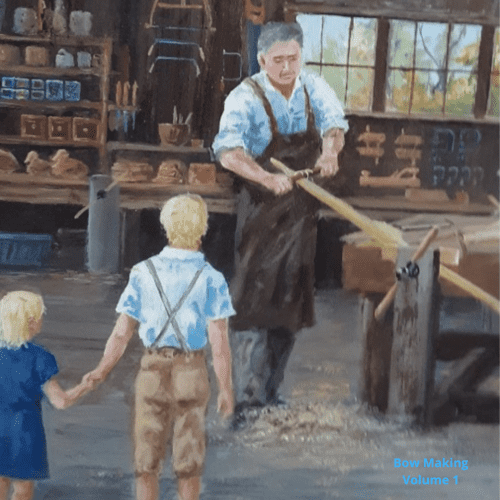 BOW MAKING VOLUME 1 These five volumes are packed with articles describing the attributes and challenges of different styles and different techniques and equipment used in making bows. Many of the articles take the reader step by step, with numbered photos, all the way through to the finished bow. Other articles focus on special challenges such as utilizing a variety of bow backing materials, and building horn bows, longbows and war bows. These five volumes are part of a series of such collections compiled into books and volumes that comprise the “Primitive Archer Golden Treasure Series”. “Although we can never return to the days when wild Native Americans roamed free over endless prairies, we can at least touch a fragment of their lost way of life by recreating and using their weapons exactly as they did during those times.” By Billy Berger “This article covers the way I make bows. There are many bowyers, with many methods, often different than those outlined here. Books and videos are readily available, and I encourage you to get them all. The more you learn, the easier bow making becomes. By necessity I could not cover every aspect of bow making in this article- that would take a book – but hopefully I have armed you with enough knowledge that you are able to turn a piece of wood into a bow.” By Mickey Lotz “The entire issue of how wooden bows break in, and what can be done to prevent problems, is a study in how stress can affect a wooden bow. My goal here is to offer some specific examples of stress-related phenomena that others can consider as they develop or refine their own methods." By Paul Comstock
BOW MAKING VOLUME 1 These five volumes are packed with articles describing the attributes and challenges of different styles and different techniques and equipment used in making bows. Many of the articles take the reader step by step, with numbered photos, all the way through to the finished bow. Other articles focus on special challenges such as utilizing a variety of bow backing materials, and building horn bows, longbows and war bows. These five volumes are part of a series of such collections compiled into books and volumes that comprise the “Primitive Archer Golden Treasure Series”. “Although we can never return to the days when wild Native Americans roamed free over endless prairies, we can at least touch a fragment of their lost way of life by recreating and using their weapons exactly as they did during those times.” By Billy Berger “This article covers the way I make bows. There are many bowyers, with many methods, often different than those outlined here. Books and videos are readily available, and I encourage you to get them all. The more you learn, the easier bow making becomes. By necessity I could not cover every aspect of bow making in this article- that would take a book – but hopefully I have armed you with enough knowledge that you are able to turn a piece of wood into a bow.” By Mickey Lotz “The entire issue of how wooden bows break in, and what can be done to prevent problems, is a study in how stress can affect a wooden bow. My goal here is to offer some specific examples of stress-related phenomena that others can consider as they develop or refine their own methods." By Paul Comstock -
 BOW MAKING VOLUME 2 Bow Backing These five volumes are packed with articles describing the attributes and challenges of different styles and different techniques and equipment used in making bows. Many of the articles take the reader step by step, with numbered photos, all the way through to the finished bow. Other articles focus on special challenges such as utilizing a variety of bow backing materials, and building horn bows, longbows and war bows. These five volumes are part of a series of such collections compiled into books and volumes that comprise the “Primitive Archer Golden Treasure Series”. “Although we can never return to the days when wild Native Americans roamed free over endless prairies, we can at least touch a fragment of their lost way of life by recreating and using their weapons exactly as they did during those times.” By Billy Berger “This article covers the way I make bows. There are many bowyers, with many methods, often different than those outlined here. Books and videos are readily available, and I encourage you to get them all. The more you learn, the easier bow making becomes. By necessity I could not cover every aspect of bow making in this article- that would take a book – but hopefully I have armed you with enough knowledge that you are able to turn a piece of wood into a bow.” By Mickey Lotz “The entire issue of how wooden bows break in, and what can be done to prevent problems, is a study in how stress can affect a wooden bow. My goal here is to offer some specific examples of stress-related phenomena that others can consider as they develop or refine their own methods." By Paul Comstock
BOW MAKING VOLUME 2 Bow Backing These five volumes are packed with articles describing the attributes and challenges of different styles and different techniques and equipment used in making bows. Many of the articles take the reader step by step, with numbered photos, all the way through to the finished bow. Other articles focus on special challenges such as utilizing a variety of bow backing materials, and building horn bows, longbows and war bows. These five volumes are part of a series of such collections compiled into books and volumes that comprise the “Primitive Archer Golden Treasure Series”. “Although we can never return to the days when wild Native Americans roamed free over endless prairies, we can at least touch a fragment of their lost way of life by recreating and using their weapons exactly as they did during those times.” By Billy Berger “This article covers the way I make bows. There are many bowyers, with many methods, often different than those outlined here. Books and videos are readily available, and I encourage you to get them all. The more you learn, the easier bow making becomes. By necessity I could not cover every aspect of bow making in this article- that would take a book – but hopefully I have armed you with enough knowledge that you are able to turn a piece of wood into a bow.” By Mickey Lotz “The entire issue of how wooden bows break in, and what can be done to prevent problems, is a study in how stress can affect a wooden bow. My goal here is to offer some specific examples of stress-related phenomena that others can consider as they develop or refine their own methods." By Paul Comstock -
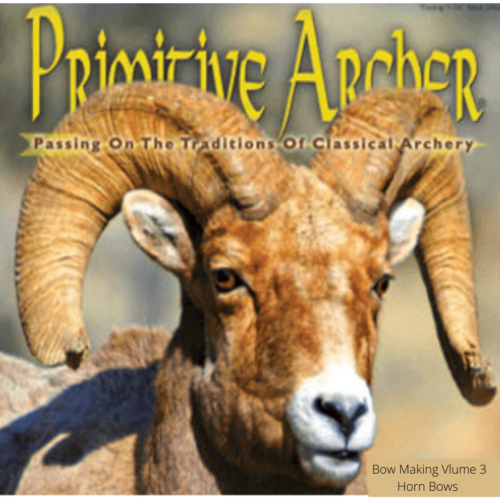 Bow Making Volume 3 Horn Bows These five volumes are packed with articles describing the attributes and challenges of different styles and different techniques and equipment used in making bows. Many of the articles take the reader step by step, with numbered photos, all the way through to the finished bow. Other articles focus on special challenges such as utilizing a variety of bow backing materials, and building horn bows, longbows and war bows. These five volumes are part of a series of such collections compiled into books and volumes that comprise the “Primitive Archer Golden Treasure Series”. “Although we can never return to the days when wild Native Americans roamed free over endless prairies, we can at least touch a fragment of their lost way of life by recreating and using their weapons exactly as they did during those times.” By Billy Berger “This article covers the way I make bows. There are many bowyers, with many methods, often different than those outlined here. Books and videos are readily available, and I encourage you to get them all. The more you learn, the easier bow making becomes. By necessity I could not cover every aspect of bow making in this article- that would take a book – but hopefully I have armed you with enough knowledge that you are able to turn a piece of wood into a bow.” By Mickey Lotz “The entire issue of how wooden bows break in, and what can be done to prevent problems, is a study in how stress can affect a wooden bow. My goal here is to offer some specific examples of stress-related phenomena that others can consider as they develop or refine their own methods." By Paul Comstock
Bow Making Volume 3 Horn Bows These five volumes are packed with articles describing the attributes and challenges of different styles and different techniques and equipment used in making bows. Many of the articles take the reader step by step, with numbered photos, all the way through to the finished bow. Other articles focus on special challenges such as utilizing a variety of bow backing materials, and building horn bows, longbows and war bows. These five volumes are part of a series of such collections compiled into books and volumes that comprise the “Primitive Archer Golden Treasure Series”. “Although we can never return to the days when wild Native Americans roamed free over endless prairies, we can at least touch a fragment of their lost way of life by recreating and using their weapons exactly as they did during those times.” By Billy Berger “This article covers the way I make bows. There are many bowyers, with many methods, often different than those outlined here. Books and videos are readily available, and I encourage you to get them all. The more you learn, the easier bow making becomes. By necessity I could not cover every aspect of bow making in this article- that would take a book – but hopefully I have armed you with enough knowledge that you are able to turn a piece of wood into a bow.” By Mickey Lotz “The entire issue of how wooden bows break in, and what can be done to prevent problems, is a study in how stress can affect a wooden bow. My goal here is to offer some specific examples of stress-related phenomena that others can consider as they develop or refine their own methods." By Paul Comstock -
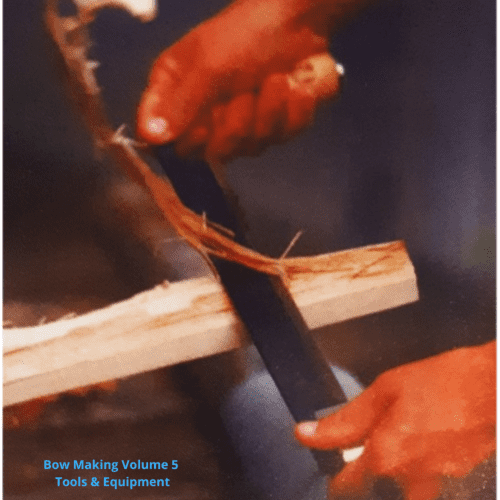 Bow Making Volume 5 Tools and Equipment These five volumes are packed with articles describing the attributes and challenges of different styles and different techniques and equipment used in making bows. Many of the articles take the reader step by step, with numbered photos, all the way through to the finished bow. Other articles focus on special challenges such as utilizing a variety of bow backing materials, and building horn bows, longbows and war bows. These five volumes are part of a series of such collections compiled into books and volumes that comprise the “Primitive Archer Golden Treasure Series”. “Although we can never return to the days when wild Native Americans roamed free over endless prairies, we can at least touch a fragment of their lost way of life by recreating and using their weapons exactly as they did during those times.” By Billy Berger “This article covers the way I make bows. There are many bowyers, with many methods, often different than those outlined here. Books and videos are readily available, and I encourage you to get them all. The more you learn, the easier bow making becomes. By necessity I could not cover every aspect of bow making in this article- that would take a book – but hopefully I have armed you with enough knowledge that you are able to turn a piece of wood into a bow.” By Mickey Lotz “The entire issue of how wooden bows break in, and what can be done to prevent problems, is a study in how stress can affect a wooden bow. My goal here is to offer some specific examples of stress-related phenomena that others can consider as they develop or refine their own methods." By Paul Comstock
Bow Making Volume 5 Tools and Equipment These five volumes are packed with articles describing the attributes and challenges of different styles and different techniques and equipment used in making bows. Many of the articles take the reader step by step, with numbered photos, all the way through to the finished bow. Other articles focus on special challenges such as utilizing a variety of bow backing materials, and building horn bows, longbows and war bows. These five volumes are part of a series of such collections compiled into books and volumes that comprise the “Primitive Archer Golden Treasure Series”. “Although we can never return to the days when wild Native Americans roamed free over endless prairies, we can at least touch a fragment of their lost way of life by recreating and using their weapons exactly as they did during those times.” By Billy Berger “This article covers the way I make bows. There are many bowyers, with many methods, often different than those outlined here. Books and videos are readily available, and I encourage you to get them all. The more you learn, the easier bow making becomes. By necessity I could not cover every aspect of bow making in this article- that would take a book – but hopefully I have armed you with enough knowledge that you are able to turn a piece of wood into a bow.” By Mickey Lotz “The entire issue of how wooden bows break in, and what can be done to prevent problems, is a study in how stress can affect a wooden bow. My goal here is to offer some specific examples of stress-related phenomena that others can consider as they develop or refine their own methods." By Paul Comstock
